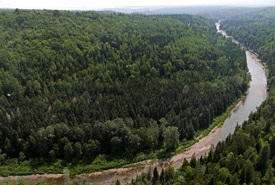Great Lakes - St. Lawrence forest

Malbaie River property, QC (Photo by Mike Dembeck)
Second in size to the boreal forest is the Great Lakes–St. Lawrence forest region, which stretches from southeastern Manitoba to the Gaspé Peninsula in Quebec. This forest is a transition between the deciduous Carolinian forests to the south and the more coniferous boreal forest. Species such as black bear, gray wolf, moose, beaver, muskrat, otter and various migratory birds rely on this habitat.
What trees are found in the Great Lakes - St. Lawrence forest?
The Great Lakes - St. Lawrence forest features a number of coniferous and deciduous trees, including:
- eastern hemlock
- eastern white pine
- red maple
- red oak
- red pine
- sugar maple
- yellow birch
What is NCC doing to protect this forest?
The Nature Conservancy of Canada has worked with many partners and donors on projects that protect this forest type over the years, including Green Mountains Nature Reserve, Kenauk and Malbaie River in Quebec, and Cockburn Island, Emma Young Forest and Crane River Tract in Ontario.




